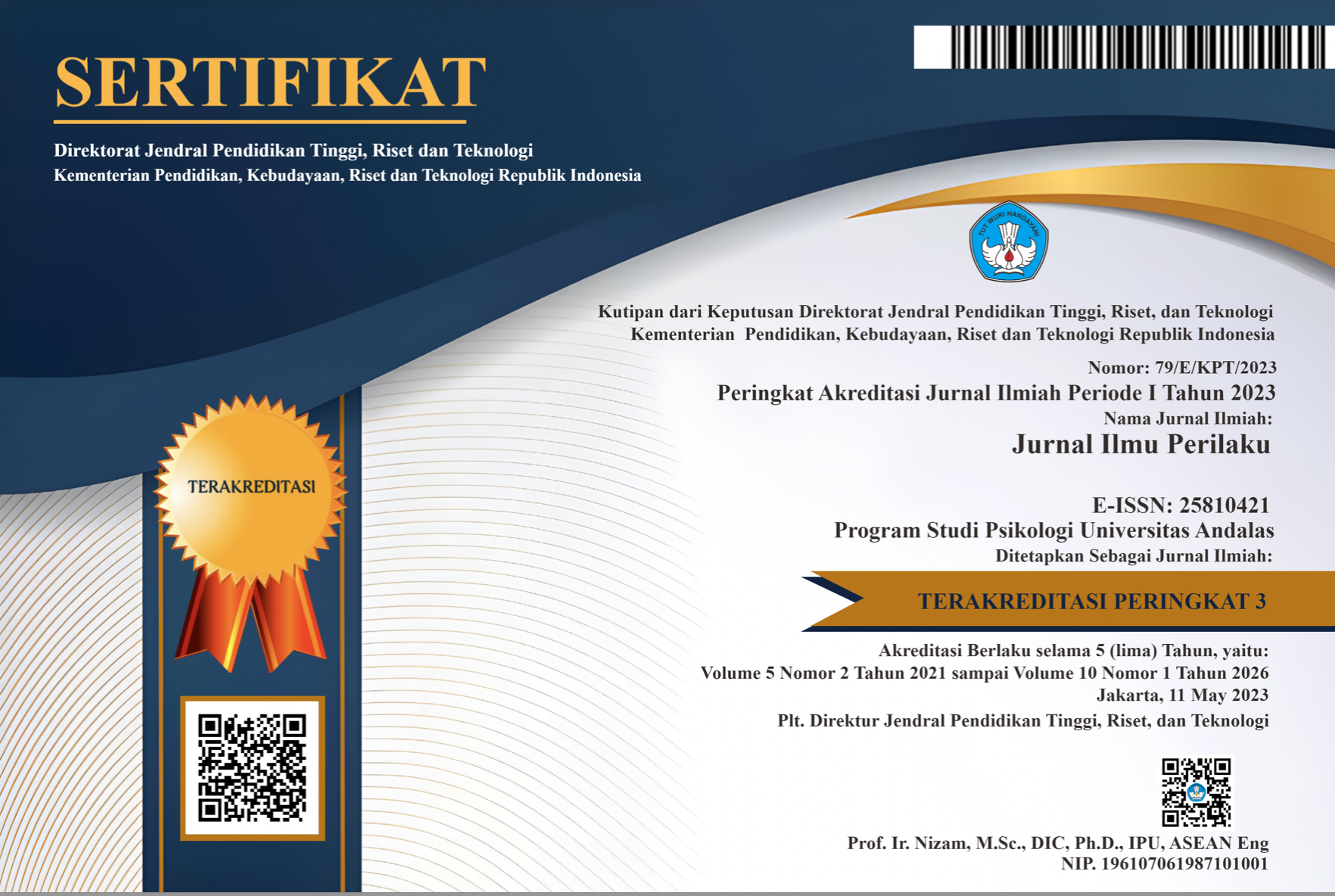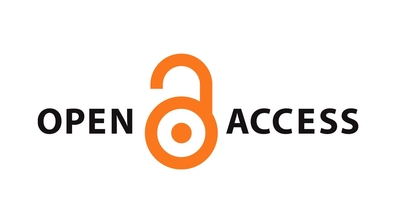Hubungan Kepribadian Neuroticism dengan Pertimbangan Protokol Kesehatan dalam Konsumsi Produk selama Pandemi Covid-19
Abstract
This study aims to see the relationship between neuroticism and the consideration of health protocols in product consumption during the Covid-19 pandemic. Although various studies have shown a relationship between individual differences and adherence to health protocols during the pandemic, there have not been many studies that specifically discuss the relationship of neuroticism with health protocol considerations in product consumption during the Covid-19 pandemic. This study used a quantitative method with a survey design. A total of 1058 respondents with an age range of 18-25 years participated in this study, which was obtained using a convenience sampling technique. Correlation analysis using Spearman's Rank Order Correlation test showed that there was a positive relationship between Neuroticism personality type and health protocol considerations in product consumption (rs = .139, p<.001) although the correlation strength was weak. The results of this study show how a person considers a health protocol in product consumption is not solely determined by personality but also other contextual factors.
Downloads
References
Andriyanty, R., & Wahab, D. (2019). Preferensi konsumen generasi Z terhadap konsumsi produk dalam negeri. Jurnal Penelitian Dan Pengabdian Kepada Masyarakat, 7(2), 280–296.
Aschwanden, D., Gerend, M. A., Luchetti, M., Stephan, Y., Sutin, A. R., & Terracciano, A. (2019). Personality traits and preventive cancer screenings in the health retirement study. Preventive Medicine, 126, 105763. https://doi.org/10.1016/j.ypmed.2019.105763
Aschwanden, D., Strickhouser, J. E., Sesker, A. A., Lee, J. H., Luchetti, M., Stephan, Y., Sutin, A. R., & Terracciano, A. (2021). Psychological and behavioural responses to Coronavirus disease 2019: The role of personality. European Journal of Personality, 35(1), 51–66. https://doi.org/10.1002/per.2281
Asselmann, E., Borghans, L., Montizaan, R., & Seegers, P. (2020). The role of personality in the thoughts, feelings, and behaviors of students in Germany during the first weeks of the COVID-19 pandemic. PLoS ONE, 15(11 November), 1–14. https://doi.org/10.1371/journal.pone.0242904
Barari, S., Caria, S., Davola, A., Falco, P., Fetzer, T., Fiorin, S., Hensel, L., Ivchenko, A., Jachimowicz, J., King, G., Kraft-Todd, G., Ledda, A., MacLennan, M., Mutoi, L., Pagani, C., Reutskaja, E., Roth, C., & Raimondi Slepoi, F. (2020). Evaluating COVID-19 Public Health Messaging in Italy: Self-Reported Compliance and Growing Mental Health Concerns 1. MedRxiv, 1–19.
Bogg, T., & Milad, E. (2020). Demographic, personality, and social cognition correlates of coronavirus guideline adherence in a U.S. sample. Health Psychology, 39(12), 1026–1036. https://doi.org/10.1037/hea0000891
Cohen, R. J., & Swerdlik, M. E. (2018). Psychological testing and assessment: Introduction to test and measurement. McGraw-Hill Education.
Corder, G. W., & Foreman, D. I. (2009). Nonparametric statistics for non-statisticians: A step-by-step approach. John Wiley & Sons, Inc.
Creswell, J. C. (2012). Education research, planning, conducting and evaluating quantitative and qualitative research (4th Ed.). Pearson.
Cuijpers, P., Smit, F., Penninx, B. W. J. H., de Graaf, R., ten Have, M., & Beekman, A. T. F. (2010). Economic costs of Neuroticism. Archives of General Psychiatry, 67(10), 1086. https://doi.org/10.1001/archgenpsychiatry.2010.130
Field, A. (2009). Discovering statistics using SPSS (3rd Ed.). SAGE Publication Ltd.
Franzen, A., & Wöhner, F. (2021). Coronavirus risk perception and compliance with social distancing measures in a sample of young adults: Evidence from Switzerland. PLOS ONE, 16(2), 1–13. https://doi.org/10.1371/journal.pone.0247447
Götz, F. M., Gvirtz, A., Galinsky, A. D., & Jachimowicz, J. M. (2021). How personality and policy predict pandemic behavior: Understanding sheltering-in-place in 55 countries at the onset of COVID-19. American Psychologist, 2(999). https://doi.org/10.1037/amp0000740.supp
Gravetter, F. J., Wallnau, L. B., Forzano, L. A. B., & Witnauer, J. E. (2017). Essentials of statistics for the behavioral sciences. Cengage Learning.
Insyirah. (2020). Peran Big Five Factors Personality dalam memprediksi kepatuhan masyarakat terhadap protokol kesehatan penanganan COVID-19 [University of Sriwijaya]. https://repository.unsri.ac.id/33178/3/RAMA_73201_04041381621053_0322098406_0028109005_01_front_ref.pdf
Kaplan, R. M., & Saccuzzo, D. P. (2017). Psychological testing: Principles, applications, and issues (9th Ed). Cengage Learning.
Kroencke, L., Geukes, K., Utesch, T., Kuper, N., & Back, M. D. (2020). Neuroticism and emotional risk during the COVID-19 pandemic. Journal of Research in Personality, 89, 104038. https://doi.org/10.1016/j.jrp.2020.104038
Lahey, B. B. (2009). Public Health Significance of Neuroticism. American Psychologist, 64(4), 241–256. https://doi.org/https://doi.org/10.1037/a0015309
Maragakis, L. (2021). Who is at high risk for severe coronavirus disease? https://www.hopkinsmedicine.org/health/conditions-and-diseases/coronavirus/coronavirus-and-covid19-who-is-at-higher-risk
Marisa, M., & Rahadi, D. R. (2020). Analisis perilaku konsumen berdasarkan tipe kepribadian pada bisnis online selama pandemi. Jurnal Manajemen Dan Profesional, 1(01), 11–22. https://doi.org/10.32815/jpro.v1i01.300
Meshram, S., Gattani, D., & Shewale, A. (2020). Association of Personality Traits With Oral Health Status. Journal of Critical Reviews, 7(14). https://doi.org/10.31838/jcr.07.14.167
Nunnally, J. C., & Bernstein, I. R. (1994). Psychometric Theory. McGraw-Hill.
Potia, A., & Praseco, D. (2020). Survey: Indonesian consumer sentiment during the coronavirus crisis. https://www.mckinsey.com/business-functions/marketing-and-sales/our-insights/survey-indonesian-consumer-sentiment-during-the-coronavirus-crisis
Roccas, S., Sagiv, L., Schwartz, S. H., & Knafo, A. (2002). The big five personality factors and personal values. Personality and Social Psychology Bulletin, 28(6), 789–801. https://doi.org/10.1177/0146167202289008
Schiffman, L., & Wisenblit, J. L. (2015). Consumer behavior (7th ed). Pearson Education.
Schober, P., Boer, C., & Schwarte, L. A. (2018). Correlation coefficients: Appropriate use and interpretation. Anesthesia and Analgesia, 126(5), 1763–1768. https://doi.org/10.1213/ANE.0000000000002864
Sheth, J. (2020). Impact of Covid-19 on consumer behavior: Will the old habits return or die? Journal of Business Research, 117, 280–283. https://doi.org/10.1016/j.jbusres.2020.05.059
Soto, C. J., & John, O. P. (2017). Short and extra-short forms of the Big Five Inventory–2: The BFI-2-S and BFI-2-XS. Journal of Research in Personality, 68, 69–81. https://doi.org/10.1016/j.jrp.2017.02.004
Turk, E., Čelik, T., Smrdu, M., Šet, J., Kuder, A., Gregorič, M., & Kralj-Fišer, S. (2021). Adherence to COVID-19 mitigation measures: The role of sociodemographic and personality factors. Current Psychology. https://doi.org/10.1007/s12144-021-02051-5
Wright, L., & Fancourt, D. (2021). Do predictors of adherence to pandemic guidelines change over time? A panel study of 22,000 UK adults during the COVID-19 pandemic. Preventive Medicine, 153, 106713. https://doi.org/10.1016/j.ypmed.2021.106713
The non-commercial use of the article is governed by the Creative Commons Attribution license as currently displayed on Creative Commons Attribution-NonCommercial-ShareAlike 4.0 International License.
JIP's spirit is to disseminate articles published are as free as possible. Under the Creative Commons license, JIP permits users to copy, distribute, display, and perform the work for non-commercial purposes only. Users will also need to attribute authors and JIP on distributing works in the journal.
Please find the rights and licenses in Jurnal Ilmu Perilaku (JIP).
- License
The non-commercial use of the article will be governed by the Creative Commons Attribution license as currently displayed on Creative Commons Attribution-NonCommercial-ShareAlike 4.0 International License.
- Author’s Warranties
The author warrants that the article is original, written by stated author(s), has not been published before, contains no unlawful statements, does not infringe the rights of others, is subject to copyright that is vested exclusively in the author and free of any third party rights, and that any necessary written permissions to quote from other sources have been obtained by the author(s).
- User Rights
JIP's spirit is to disseminate articles published are as free as possible. Under the Creative Commons license, JIP permits users to copy, distribute, display, and perform the work for non-commercial purposes only. Users will also need to attribute authors and JIP on distributing works in the journal.
- Rights of Authors
Authors retain the following rights:
- Copyright, and other proprietary rights relating to the article, such as patent rights,
- The right to use the substance of the article in future own works, including lectures and books,
- The right to reproduce the article for own purposes, provided the copies are not offered for sale,
- The right to self-archive the article.
- Co-Authorship
If the article was jointly prepared by other authors, the signatory of this form warrants that he/she has been authorized by all co-authors to sign this agreement on their behalf, and agrees to inform his/her co-authors of the terms of this agreement.
- Termination
This agreement can be terminated by the author or JIP upon two months’ notice where the other party has materially breached this agreement and failed to remedy such breach within a month of being given the terminating party’s notice requesting such breach to be remedied. No breach or violation of this agreement will cause this agreement or any license granted in it to terminate automatically or affect the definition of JIP.
- Royalties
This agreement entitles the author to no royalties or other fees. To such extent as legally permissible, the author waives his or her right to collect royalties relative to the article in respect of any use of the article by JIP or its sublicensee.
- Miscellaneous
JIP will publish the article (or have it published) in the journal if the article’s editorial process is successfully completed and JIP or its sublicensee has become obligated to have the article published. JIP may conform the article to a style of punctuation, spelling, capitalization, referencing and usage that it deems appropriate. The author acknowledges that the article may be published so that it will be publicly accessible and such access will be free of charge for the readers.










